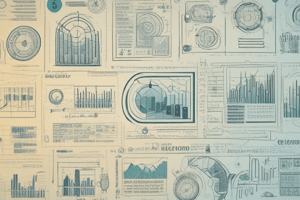Podcast
Questions and Answers
What is the first step in the data gathering process?
What is the first step in the data gathering process?
- Determine the method for data gathering
- Design data gathering forms
- Collect the data
- Set the objectives for collecting data (correct)
What is a consequence of improperly collected data?
What is a consequence of improperly collected data?
- Enhanced credibility of the study
- Inability to repeat and validate the study (correct)
- Improved decision making for policy
- Accurate representation of research questions
Which of the following statements best describes primary sources?
Which of the following statements best describes primary sources?
- They summarize the findings of primary sources
- They are less reliable than secondary sources
- They offer original insights and first-hand accounts (correct)
- They provide a second-hand account of information
Which of the following is NOT an importance of data collection?
Which of the following is NOT an importance of data collection?
What method should be determined after setting the objectives for data collection?
What method should be determined after setting the objectives for data collection?
The analysis and interpretation of primary sources are typically found in which type of sources?
The analysis and interpretation of primary sources are typically found in which type of sources?
What does the data collection process aim to achieve?
What does the data collection process aim to achieve?
What is a key feature of properly collected data?
What is a key feature of properly collected data?
What is the primary purpose of descriptive statistics?
What is the primary purpose of descriptive statistics?
Which step comes first in the process of statistics?
Which step comes first in the process of statistics?
Which of the following statements is an example of inferential statistics?
Which of the following statements is an example of inferential statistics?
Which method of collecting primary data involves direct interaction with the participant?
Which method of collecting primary data involves direct interaction with the participant?
What is a key difference between qualitative and quantitative variables?
What is a key difference between qualitative and quantitative variables?
What is the result of applying the process of descriptive statistics?
What is the result of applying the process of descriptive statistics?
What is the primary characteristic of the focus group method?
What is the primary characteristic of the focus group method?
Which method for collecting secondary data involves official government documentation?
Which method for collecting secondary data involves official government documentation?
If a badminton player wants to assess his performance, which statistical method should he use?
If a badminton player wants to assess his performance, which statistical method should he use?
Which of the following describes a situation where inferential statistics is used?
Which of the following describes a situation where inferential statistics is used?
What is a significant factor to consider when using data for research?
What is a significant factor to consider when using data for research?
What characteristic do both qualitative and quantitative variables share?
What characteristic do both qualitative and quantitative variables share?
In the process of statistics, which step follows identifying the research objective?
In the process of statistics, which step follows identifying the research objective?
Which method does NOT belong to the collection of primary data?
Which method does NOT belong to the collection of primary data?
Which of the following is NOT a method of collecting secondary data?
Which of the following is NOT a method of collecting secondary data?
Which step is crucial for ensuring applicable research outcomes?
Which step is crucial for ensuring applicable research outcomes?
Which level of measurement categorizes objects or events without any intrinsic ordering?
Which level of measurement categorizes objects or events without any intrinsic ordering?
What characteristic distinguishes ordinal levels of measurement from nominal levels?
What characteristic distinguishes ordinal levels of measurement from nominal levels?
Which of the following is an example of the interval level of measurement?
Which of the following is an example of the interval level of measurement?
What is a defining property of the interval level of measurement?
What is a defining property of the interval level of measurement?
Ranked categories are a feature of which level of measurement?
Ranked categories are a feature of which level of measurement?
Which example illustrates a nominal level of measurement?
Which example illustrates a nominal level of measurement?
What type of measurement involves categories that have both order and equal intervals?
What type of measurement involves categories that have both order and equal intervals?
Which of the following measurements does not have a true zero point?
Which of the following measurements does not have a true zero point?
What does the level of measurement refer to?
What does the level of measurement refer to?
Which of the following is an example of nominal level measurement?
Which of the following is an example of nominal level measurement?
Which characteristic does not apply to nominal level measurements?
Which characteristic does not apply to nominal level measurements?
What is the primary function of the nominal level of measurement?
What is the primary function of the nominal level of measurement?
Which of these variables would best be classified at the nominal level?
Which of these variables would best be classified at the nominal level?
What does identifying measurement levels help with in data analysis?
What does identifying measurement levels help with in data analysis?
Which statement about levels of measurement is incorrect?
Which statement about levels of measurement is incorrect?
In the context of levels of measurement, which of the following typically represents qualitative data?
In the context of levels of measurement, which of the following typically represents qualitative data?
Flashcards are hidden until you start studying
Study Notes
Understanding the Process of Statistics
- Define a clear research objective to guide the study.
- Gather necessary information systematically to address research questions.
Data Collection
- Process involves gathering and measuring information on variables of interest.
- Enables answering research questions, testing hypotheses, and evaluating outcomes.
Importance of Data Collection
- Empowers informed decision-making.
- Identifies problems and supports the development of accurate theories.
- Provides evidence for arguments and secures funding.
- Increases return on assets and enhances quality of life.
Consequences of Improper Data Collection
- Inaccuracy in answering research questions.
- Challenges in replicating and validating studies.
- Generation of distorted findings, leading to resource wastage.
- Misleading other researchers and poor public policy decisions.
- Potential harm to human and animal subjects involved in research.
Steps in Data Gathering
- Establish objectives for data collection.
- Identify required data based on objectives.
- Decide on data collection methods and outline data collection points.
- Design data gathering instruments.
- Execute the data collection process.
Sources of Data
- Primary sources offer firsthand accounts and are typically authoritative.
- Secondary sources provide an analysis or interpretation of primary data.
Methods of Collecting Primary Data
- Direct Personal Interviews: Direct interaction with the interviewee to gather information.
- Indirect/Questionnaire Method: Access existing data collected for earlier studies.
- Focus Groups: Group interviews guided by a facilitator to explore predetermined topics.
- Experiments: Involves direct human intervention to observe effects on variables.
- Observation: Gathering data by recording observations of the phenomenon in real time.
Methods of Collecting Secondary Data
- Utilize published reports in newspapers and periodicals.
- Review financial data in annual reports.
- Analyze institutional records.
- Examine internal government department reports.
- Extract information from official publications.
Validation of Data Sources
- Investigate the reliability and validity of data collection methods used by sources.
- Avoid using inappropriate data for research inquiries.
Organizing and Summarizing Data
- Implement descriptive statistics to summarize information via numerical measures, charts, and graphs.
- Aim to provide an overview of collected data.
Inferential Statistics
- Generalizes sample data to the broader population and assesses the reliability of results.
Qualitative vs. Quantitative Variables
- Variables are characteristics that differentiate individuals in a population.
- Qualitative variables categorize attributes without numerical measurement.
- Quantitative variables involve numerical measurements providing measurable characteristics.
Levels of Measurement
- Nominal Level: Classifies or categorizes events without a logical order; examples include type of school or eye color.
- Ordinal Level: Includes a logical order in categories; examples are military ranks or socioeconomic classes.
- Interval Level: Features ordered values with equal distances between scales; examples involve temperature and IQ measurements.
Studying That Suits You
Use AI to generate personalized quizzes and flashcards to suit your learning preferences.




